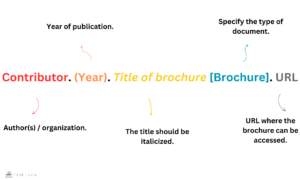How to Cite a Brochure in APA
- Written by Tomas Elliott (Ph.D.)
- Published on 06/21/2024
Citing brochures, pamphlets, or flyers in APA style follows a specific format akin to citing reports. This ensures that the sources are properly attributed and can be easily located by readers. The American Psychological Association (APA) provides clear guidelines on how to cite these types of materials. The following details outline the process of citing a brochure in APA style, using an example to illustrate the application of these guidelines.
GENERAL FORMAT FOR CITING BROCHURES
When citing a brochure, pamphlet, or flyer, the format used is similar to that of report references. This uniformity simplifies the citation process and maintains consistency across various types of references. A critical aspect of citing brochures is recognizing whether the brochure has an organizational author or individual authors. In many cases, brochures are produced by organizations rather than individual authors.
- Contributor: This acknowledges the entity responsible for the creation and distribution of the content. Including the Contributor in the citation provides clarity on the source of the information and ensures proper attribution.
- Title and Description: After the author’s name, the title of the brochure is listed. The title should be italicized to distinguish it from other elements of the citation. Following the title, include a description in square brackets, such as “[Brochure],” to specify the type of document being referenced. This additional information helps readers understand the nature of the source at a glance.
- Publication Year and URL: The year of publication is noted in parentheses after the author’s name. This provides context regarding the currency of the information. Finally, include the URL where the brochure can be accessed. Providing the direct link to the brochure allows readers to retrieve the document for further review or verification.
EXAMPLE OF CITING A BROCHURE
| Citation |
American Diabetes Association. (2023). Diabetes management and prevention [Brochure]. https://www.diabetes.org/brochures/diabetes-management-prevention.pdf
|
| Structure |
Author. (Year). Title of brochure [Brochure]. URL
|
 |
Use the Full Name of the Organization: When citing a brochure from an organization, ensure that the full, official name of the organization is used as the author. Avoid abbreviations or informal names unless the organization is widely recognized by its abbreviation. Check for Publication Dates on the Brochure: Sometimes brochures might not have a clear publication date on the cover. Check inside the brochure or on the last page for publication details. If no date is available, use “n.d.” to indicate “no date.” Include Specific Edition Information: If the brochure specifies an edition (e.g., 2nd edition, revised edition), include this information after the title and before the description in square brackets. This helps in identifying the exact version of the brochure used. Use Proper Punctuation and Formatting: Pay attention to punctuation and formatting rules. Ensure that periods, commas, and other punctuation marks are placed correctly. Titles should be italicized, and descriptions should be within square brackets. Consistent and correct formatting is essential for clarity and professionalism. |
GIVE YOUR CITATIONS A BOOST TODAY
Start your TypeCite Boost 3 day free trial today. Then just $4.99 per month to save your citations, organize in projects, and much more.
SIGN UP